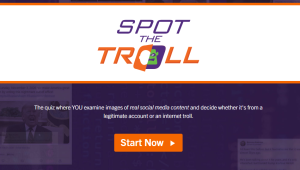10 Web Fact Checking: going upstream in the digital age
Learning Objectives
Critically evaluating information online is needed in order to identify and assess misinformation.
- The need to check facts
- Evaluate your sources
- What is confirmation bias and how to avoid it
- Check for previous work
- Go upstream to the source to check information
- Read laterally and circle back
Fact-checking essentials
The web offers endless information and opportunity. It also poses unique challenges. Much of the information you access in your daily work is through social media streams. To deal with the information flow, you need concrete strategies and tactics for tracing claims to sources and for analyzing the nature and reliability of those sources.
Misinformation (incorrect information) and disinformation (deliberately misleading information) can affect a business’ consumer confidence and bottom line. Your ability to identify inaccuracies can help prevent the spread of bad information, help you critically evaluate information as a consumer, and help you address any disinformation in your own organization.
Evaluate your sources

Using the APPEAL method discussed last chapter, ask yourself a series of questions to determine how reliable your source is.
- APPEAL © Todd Hillsley is licensed under a CC0 (Creative Commons Zero) license
Confirmation bias
Confirmation bias is the tendency for people to selectively search for information that confirms their already held beliefs and to reject evidence that contradicts their opinions. People also tend to reject evidence that contradicts their opinions.
Confirmation bias is especially common with established beliefs and with emotional issues. It may develop when a researcher favours evidence that supports their claims without properly assessing its validity. They may interpret this evidence to support their bias and ignore whether it agrees or disagrees with previous hypotheses.
Avoid confirmation bias by reading different viewpoints, challenging your own assumptions, and considering alternative truths.
Use alternate search engines and incognito browsing to overcome search bias and protect your privacy.
Check for previous work
When you encounter a claim you want to check, your first move might be to see if sites like Politifact, Snopes, or another reputable fact-checking source have researched the claim.
A reputable fact-checking site or subject wiki may have done much of the leg work for you by tracing claims to their source, identifying the owners of various sites, and linking to reputable sources for counterclaims.
Information from educational institution sites (often ending in .edu and edu.au) and government websites (ending in .gov. and .gov.au) may provide verifiable information. Online encyclopaedias, scientific organisations, and history museums can also be used for fact verification.
These are some fact-checking sites:
The following organisations are generally regarded as reputable fact-checking organisations focussed mainly on U.S. national news:
Go upstream to the source
The second move, after finding previous fact-checking work, is to “go upstream.” Use this move if previous fact-checking work was not suffieicnt to check the facts.
Consider this claim on Bettina Arndt’s substack site:[9]
“Women were the forgotten people in this election”, pronounced Katherine Deves on Sky News this week. This Liberal candidate for Warringah claimed “women want to be listened to and they need to have a voice,” suggesting the Morrison government’s failure to pay attention to women contributed to the 6% swing against her in Tony Abbott’s former seat.
Is this claim true?
Check the credibility of this article by considering the author, the site, and when it was last revised. However, this is a rewrite of a fact published upstream on another page. Like most news pages on the web, this one provides no original information. It’s just a rewrite of an upstream page.
All the information here has been collected from Sky News and presumably fact-checked by Bettina Arndt. It’s called “reporting on reporting.”
The first step is to go upstream. Go to the original story and evaluate it. When you get to Sky News, then you can start asking questions about the site or the source. And it may be that for some of the information in the Sky News article you’d want to go a step further back and check their primary sources. But you have to start there, not with Bettina Arndt.
Read laterally and circle back
You may find that the source is reputable, such as an academic journal or government agency. If so, you can stop there. If not, you’re going to need to read laterally, finding out more about this original source and whether it is trustworthy.
If you find the source is not trustworthy, complex questions emerge, or the claim turns out to have multiple sub-claims–then you circle back, and start a new process. Rewrite the claim, try a new search of fact-checking sites, or find an alternate source.
 “Spot the Troll” was created by The Clemson University Media Forensics Hub. The site asks you to determine whether or not the images in the examples are from real people or from an internet troll. An internet troll may be either a “bot”, a social media account run by a computer, or an individual whose sole purpose is writing posts with upsetting or confrontational content to provoke an emotional response.
“Spot the Troll” was created by The Clemson University Media Forensics Hub. The site asks you to determine whether or not the images in the examples are from real people or from an internet troll. An internet troll may be either a “bot”, a social media account run by a computer, or an individual whose sole purpose is writing posts with upsetting or confrontational content to provoke an emotional response.
- Take the Spot the Troll quiz.[10]
- Spot the troll screenshot © Spot the Troll is licensed under a CC0 (Creative Commons Zero) license
This chapter is derived from Caulfield & McDonald. [11]
Chapter Review
- Question the validity of the content you read
- Evaluate the source for inclusion in your academic writing
- Question your biases
- Read the source’s sources, and read around the topic to confirm the truth
Media Attributions
- APPEAL © Todd Hillsley is licensed under a CC0 (Creative Commons Zero) license
- Spot the troll screenshot © Spot the Troll is licensed under a CC0 (Creative Commons Zero) license
- Promotbot Russia, 'A Promobot robot was killed by a self-driving Tesla car' , Promobot Russia, YouTube, 8 January 2019, https://www.youtube.com/watch?v=0s4nxcleVd0 ↵
- Electrek, A robot company stages Tesla crash as a PR stunt, media buys it, January 8 2019, https://electrek.co/2019/01/08/tesla-crash-robot-pr-stunt-media/ ↵
- Google, Google Fact Check Tools, https://toolbox.google.com/factcheck/explorer/search/tesla;hl=en ↵
- Royal Melbourne Institute of Technology and Australian Broadcasting Corporation, RMIT ABC Fact Check, https://apo.org.au/organisation/305275 ↵
- The Conversation, Articles on FactCheck, https://theconversation.com/au/factcheck ↵
- The Poynter Institute, PolitiFact, http://www.politifact.com/ ↵
- Annenberg Public Policy Center, FactCheck.org, http://www.factcheck.org/ ↵
- Snopes Media Group, Snopes, http://www.snopes.com/ ↵
- Arndt, B 2022, Morrison's women problem, <https://bettinaarndt.substack.com/p/morrisons-women-problem>. ↵
- The Clemson University Media Forensics Hub, Spot the Troll, https://spotthetroll.org/ ↵
- M Caulfield & L McDonald, Web fact-checking licensed under a Creative Commons Attribution 4.0 International licence. in Building relationships with business communication, 2022. https://caul-cbua.pressbooks.pub/businesscommunication/chapter/web-literacy/ ↵

